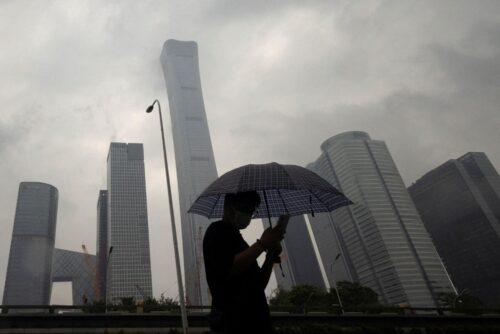U.S. lays first charges against China-based fentanyl chemical producers
The Justice Department has accused four Chinese chemical manufacturers and eight individuals for aiding the production and flow of illegal fentanyl into the U.S.

The U.S. filed the first prosecutions against China-based actors for selling key chemicals used to make fentanyl, the highly-addictive painkiller that has driven an opioid crisis in the country and has been linked to thousands of deaths nation-wide.
The Department of Justice (DOJ) filed criminal charges in New York on June 23 against four Chinese chemical manufacturing companies and eight individuals, alleging that they “knowingly manufactured, marketed, sold, and supplied precursor chemicals” for illegal fentanyl production in the U.S. Those named include:
- Hubei Amarvel Biotech (AmarvelBio)
- Anhui Rencheng Technology (Rencheng)
- Anhui Moker New Material Technology
- Hefei GSK Trade (Hebei Gesuke Trading and Hebei Sinaloa Trading)
- Bruce Wang (Qingzhou Wang)
- Chiron Chen (Yiyi Chen)
- Anita or Er Yang (Fnu Lnu)
- Shutong Wang
- Eva Ruan (Shifang Ruan)
- Sarah Zhao (Xinyu Zhao)
- Ellie Gao (Yue Gao)
- Ruiqing Li
“I promised that the Justice Department would never forget the victims of the fentanyl epidemic,” U.S. Attorney General Merrick B. Garland said in the press release. “I also promised that we would never stop working to hold accountable those who bear responsibility for it. That includes not only going after the leaders of the Cartels, their drug and gun traffickers, their money launderers, security forces, and clandestine lab operators — it also includes stopping the Chinese chemical companies that are supplying the cartels with the building blocks they need to manufacture deadly fentanyl.”
During the investigations of the three indictments, the U.S. Drug Enforcement Administration (DEA) seized more than 200 kilograms (441 pounds) of precursor chemicals to make fentanyl, which the DOJ said was a “quantity that could contain enough deadly doses to kill 25 million Americans.”
China’s Foreign Ministry “strongly condemned” the charges in a statement on June 24 and has lodged serious démarches against the U.S. China urges the U.S. to “stop shifting the blame” and to “stop using fentanyl-related issues as a pretext to sanction, indict, or offer awards to hunt Chinese companies or nationals,” the statement said, while calling for a lift on all sanctions placed on Chinese counternarcotics law enforcement institutions and the release of the Chinese nationals under “illegal arrest.”
The U.S. Department of the Treasury’s Office of Foreign Assets Control (OFAC) sanctioned more than a dozen Chinese and Mexican companies on May 30 for their involvement “in the international proliferation of equipment used to produce illicit drugs,” such as the sale of pill press machines used to impress counterfeit trade markings onto illegal pills often laced with fentanyl and bound for the U.S.
Just one week ago, U.S. Secretary of State Antony Blinken had called for “greater cooperation” to tackle fentanyl trafficking during his two-day trip to Beijing. “We agreed to explore setting up a working group or joint effort so that we can shut off the flow of precursor chemicals, which helped fuel this crisis and a growing number of deaths,” he said, after meeting with Chinese leader Xí Jìnpíng 习近平 on June 19.
Deadly fentanyl
Fentanyl is the number one killer of Americans aged 18 to 49, with an estimated 110,000 American overdoses in 2022, according to the U.S. Centers for Disease Control and Prevention (CDC). It is a potent synthetic opioid drug that is approximately 100 times more potent than morphine and 50 times more potent than heroin as an analgesic.
While fentanyl use is approved by the U.S. Food and Drug Administration (FDA) to help treat severe pain and for anesthetic purposes, its illegal use, production, and trafficking have greatly contributed to a synthetic opioid crisis in the U.S. in recent years. The drug is relatively easy to synthesize, and instructions on how to manufacture it are readily available on the open internet and the dark web.
China’s pivot to precursor chemical production
China remains the “primary source of fentanyl and fentanyl-related substances” trafficked through international mail and express consignment operations, as well as for fentanyl-related substances trafficked into the United States, according to a 2020 report by the DEA.
In the past, fentanyl was shipped directly to the U.S. from China. However, in May 2019, the Chinese government officially controlled all forms of fentanyl as a class of drugs, following pressure from the previous three U.S. administrations.
The restrictions initially led to slight reductions in the flow of illegal fentanyl from China to the U.S. But Mexican cartels took control of the supply by importing the precursor chemicals used to make the drug and then shipping the finished product across the border. While the Chinese government put controls on fentanyl in its final form, it did not place similar controls on the key building blocks used to make fentanyl.
Chinese manufacturers and traffickers have since adapted to the restrictions by focusing on making the key ingredients to fentanyl, while the final production of the drug is now done at cartel laboratories in Mexico: In the June 23 prosecutions, the Justice Department accused Amarvel Biotech of targeting precursor chemical customers in Mexico, including the advertisement of fentanyl precursors as a “Mexico hot sale” and guaranteeing “100% stealth shipping” abroad on its website and a host of other storefront sites.
Illicit economies between Chinese operations and Mexican cartels continue to push the flow of fentanyl into the U.S. through money laundering networks that circumvent formal banking systems, while small and middle-level actors in China’s chemical and pharmaceutical industries churn out its precursor chemicals.
Meanwhile, India is now emerging as another source for finished fentanyl powder and key chemicals, as Mexican cartels diversify their supply chains.
U.S.-China tensions choke up the fight against fentanyl
Since 2020, China’s cooperation with U.S. counternarcotics efforts have significantly declined amid deteriorating ties between the two superpowers.
In August 2022, China suspended all counternarcotics and law enforcement cooperation with the U.S., as part of Beijing’s broader protest over a highly-controversial visit to Taiwan by U.S. House Speaker Nancy Pelosi.
“There is no such thing as illegal trafficking of fentanyl between China and Mexico,” Chinese Foreign Ministry spokesperson Máo Níng 毛宁 said when asked about efforts to curb the flow of fentanyl to the U.S. on April 6. “The root cause of the overdose lies in the U.S. itself. The problem is completely ‘made in [the] U.S.A.’ The U.S. needs to face up to its own problems, take more substantial measures to strengthen domestic regulation and reduce demand. It cannot relapse into the illness of ‘letting others take the pill when it is sick.’”




